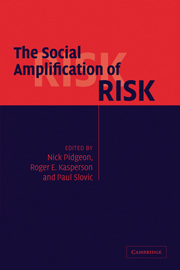Book contents
- Frontmatter
- Contents
- List of figures
- List of tables
- List of contributors
- Acknowledgments
- Introduction
- Part I Conceptual foundations
- Part II Risk signals and the mass media
- Part III Public perceptions and social controversy
- Part IV Risk ripples and stigma effects
- 13 Integrating politics with the social amplification of risk framework: insights from an exploration in the criminal justice context
- 14 Nuclear stigma
- Part V Policy and management
- Bibliography
- Index
14 - Nuclear stigma
Published online by Cambridge University Press: 06 July 2010
- Frontmatter
- Contents
- List of figures
- List of tables
- List of contributors
- Acknowledgments
- Introduction
- Part I Conceptual foundations
- Part II Risk signals and the mass media
- Part III Public perceptions and social controversy
- Part IV Risk ripples and stigma effects
- 13 Integrating politics with the social amplification of risk framework: insights from an exploration in the criminal justice context
- 14 Nuclear stigma
- Part V Policy and management
- Bibliography
- Index
Summary
News reports about the accidents and events associated with modern science and technology have, in certain cases, stigmatized places, products, or technologies (Gregory et al. 1995). Our understanding of these results are informed by the conceptual model outlined in the Social Amplification of Risk Framework, and as modified subsequently (see chapter 1 this volume, figure 1.2) to highlight the stigma effects (Kasperson, Renn, Slovic et al. 1988; Kasperson 1992; Flynn, Slovic, and Kunreuther 2001). This chapter considers nuclear stigma in the United States with attention to how it came about. Understanding how nuclear stigma was created is basic to understanding what to do about it.
The danger of nuclear technology is exposure to radiation with potential consequences of death, cancer, and genetic mutations. The long-lasting hazards of many radioactive materials, even at low or moderate exposures, which may or may not prove fatal until years later, constitute dreaded threats to existing and future biological existence (Slovic 1987). During the last quarter of the twentieth century a history of repeated failures in nuclear management was revealed. Some of this history goes back to the Manhattan atomic bomb project and taken together it provides a basis for nuclear stigma. This paper summarizes a study of the United States nuclear experience. It focuses on the official and expert standards, values, and levels of management performance applied to nuclear technologies in contrast with the public's expectations.
- Type
- Chapter
- Information
- The Social Amplification of Risk , pp. 326 - 352Publisher: Cambridge University PressPrint publication year: 2003
- 21
- Cited by



